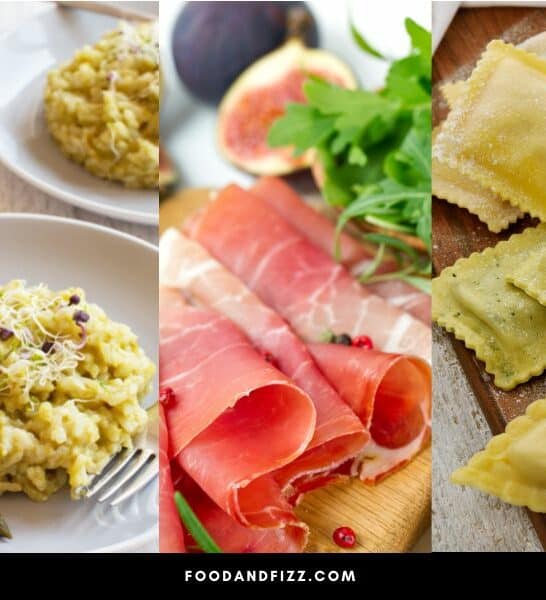Contrary to what most people believe, Italy is not just about pasta and pizza. While they certainly made those two things world-famous, Italy boasts of other delicious specialties that vary from region to region, from meat and seafood dishes to soups and stews, vegetables, rice, and desserts.
The dishes are as different and as varied as the regions they originated from, each one making use of ingredients abundant in their area, while also being influenced by neighboring areas.
Northern Italy is known for its risotto and hearty meat dishes like Osso Bucco. In this article, we’ll travel to Northern Italy to learn more about its distinctive cuisine.
26 Most Popular Northern Italian Foods
- Osso Bucco
- Pesto Alla Genovese
- Risotto Alla Milanese
- Tiramisu
- Panna Cotta
- Focaccia
- Risi e Bisi
- Fonduta
- Fegato Alla Veneziana
- Ragu Alla Bolognese
- Canerdeli
- Gnocchi
- Baccala Mantecato
- Capriolo Alla Valdostana
- Brasato Al Barolo
- Ravioli
- Polenta
- White Truffles
- Balsamic Vinegar
- Prosciutto Di San Daniele and Prosciutto di Parma
- Speck
- Bresaola
- Parmigiano Reggiano
- Fontina
- Mascarpone
- Gorgonzola
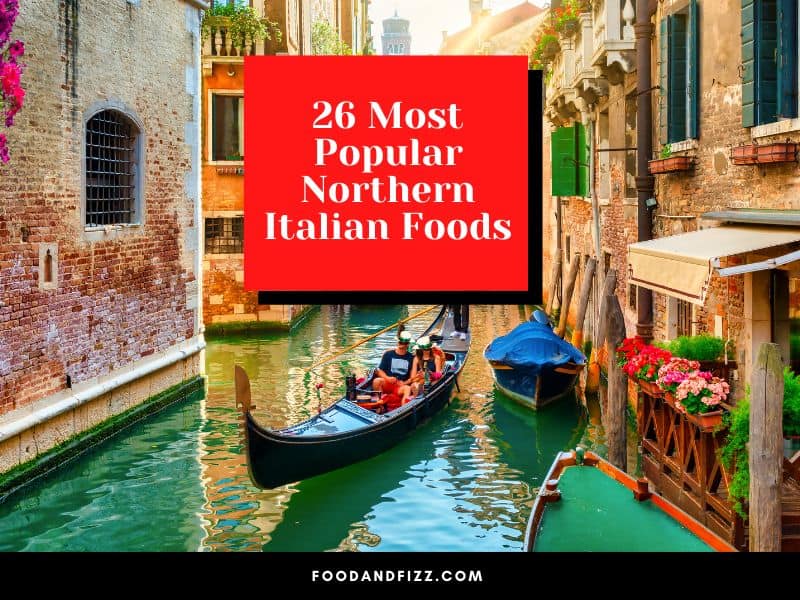
26 Most Popular Northern Italian Foods
1. Osso Bucco
Osso Bucco is a traditional, slow-cooked meat dish that originated in the Lombardy region of Italy. It consists of veal shanks braised in broth, white wine, vegetables like tomato, carrots, and celery, and optionally topped with gremolata–a parsley, lemon zest, and garlic dressing. Its name means “bone with a hole” in Italian.
Because veal shanks are a tougher cut of meat, it needs to be cooked longer to achieve the right texture. The melt-in-your-mouth texture of Osso bucco isn’t an accident, it is the result of a long, slow, cooking process designed to get the optimal flavor and buttery texture out of the meat.
- Characteristics: Slow-cooked meat dish, rich, hearty sauce
- Featured Ingredient: Veal or beef shank
- Type of Dish: Stew
- Region of Origin: Lombardy

2. Pesto Alla Genovese
Popular regional dishes usually showcase either the best ingredients or ingredients that are found in abundance in that region.
This is especially the case with pesto, or Pesto alla Genovese, which originated in Genoa in the Ligurian region of Italy. Liguria is home to the best basil in Italy, and what better way to use it than in pesto, where it truly shines.
Pesto is a well-loved pasta sauce known for its freshness and herbaceousness. It is traditionally made of basil leaves, pine nuts, garlic, salt, olive oil, and a hard cheese like Parmigiano Reggiano.
Nowadays pesto can be found bottled everywhere, but it is simple enough to make at home, and frankly, it tastes better when you make it yourself.
In simple dishes like this, using the best ingredients is imperative, as you can really taste the difference. Good quality olive oil, fresh basil, freshly crushed garlic and pine nuts truly make this dish work.
It is typically a pasta sauce but can be served over meat or fish, roasted vegetables, mashed potatoes, and bread and can even work as a dip.
- Characteristics: Fresh, herbaceous sauce made with basil, pine nuts, garlic, and olive oil
- Featured Ingredient: Fresh Genovese basil
- Type of Dish: Usually served over pasta, but can be used as a dressing for meat, seafood, and vegetables
- Region of Origin: Genoa, Liguria
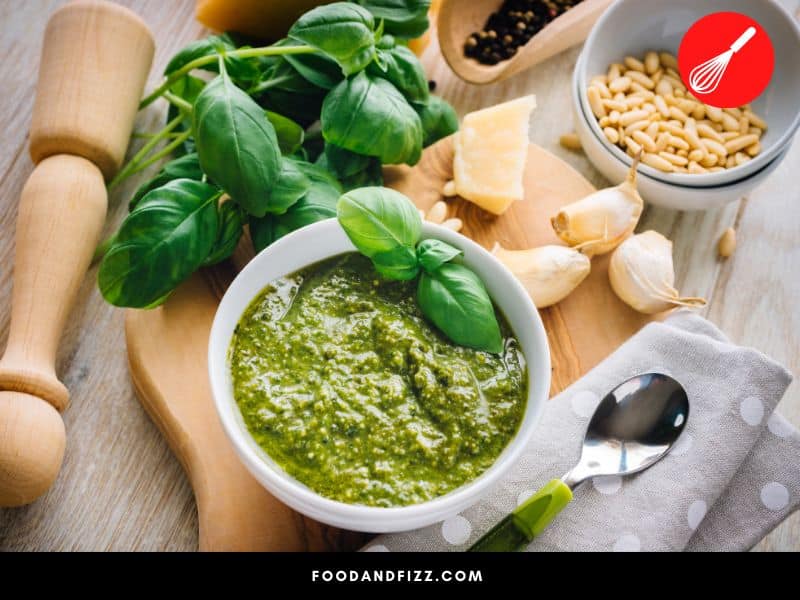
3. Risotto Alla Milanese
While the South of Italy is typically associated with its pizzas and pasta, the North of Italy is known for its meat dishes and rice dishes, specifically risotto.
Risotto is a rice dish made with short-grain, high-starch rice like arborio or carnaroli, which is cooked in broth.
The perfect risotto is creamy in consistency with the rice still al dente. There are many different types of risotto, depending also on the region where it is made.
Risotto Alla Milanese or saffron risotto, is one of the most famous, and also has an interesting history. According to popular legend, the dish was invented by a glassmaker called Valerio of Flanders and his apprentice, known simply as Zafferano because of his fondness for using the spice in his work, to make the colors more vibrant.
The story goes that Valerio of Flanders joked that his apprentice was so enamored with saffron that if given the chance, he would probably add it to his food and eat it. And that is what supposedly happened.
On the wedding day of the daughter of Valerio of Flanders, it is said that Zafferano added some saffron to classic butter risotto, turning it into a pretty, golden-yellow hue.
The guests were reportedly impressed with its color and flavor, and an iconic dish was born.
The traditional accompaniment of Risotto Alla Milanese is Osso Bucco.
- Characteristics: Creamy rice dish with a golden yellow hue
- Featured Ingredient: Saffron
- Type of Dish: Rice dish, traditionally served with Osso Bucco
- Region of Origin: Milan, Lombardy

4. Tiramisu
Who doesn’t love tiramisu? Tiramisu is perhaps Italy’s most famous dessert but not everyone knows that it is actually a pretty recent invention.
The place where it originated is a hotly contested one, a fight between two Northern Italian regions– Veneto and Friuli Venezia Giulia.
The widespread belief is that a restaurateur named Ado Campeol, known as the “father of Tiramisu”, first served it at his La Beccherie restaurant, located in Treviso in Veneto.
It was said to be a version of the traditional Venetian dessert called Sbatudin.
However, according to further research, it was found that tiramisu was actually first seen a few decades earlier, in the 1930s, and was the result of creative inspiration by Norma Pielli, whose family managed the Roma Hotel in Tolmezzo, Udine, in Friuli Venezia Giulia.
The latter claim has won, as the Ministry of Agricultural, Food and Forestry Policies awarded the claim to Friuli Venezia Giulia, adding it to the region’s Traditional Food Products (PAT) list.
Tiramisu in Italian means “pick me up”, and it is an apt name for the coffee-infused, sometimes liquor-infused layers of ladyfingers (savoiardi) filled with a mixture of whipped mascarpone cheese, eggs, sugar, and cocoa.
- Characteristics: Elegant no-bake, coffee-flavored dessert, the most well-known Italian dessert
- Featured Ingredient: Coffee, Mascarpone cheese
- Type of Dish: Dessert
- Region of Origin: Friuli Venezia Giulia or Veneto
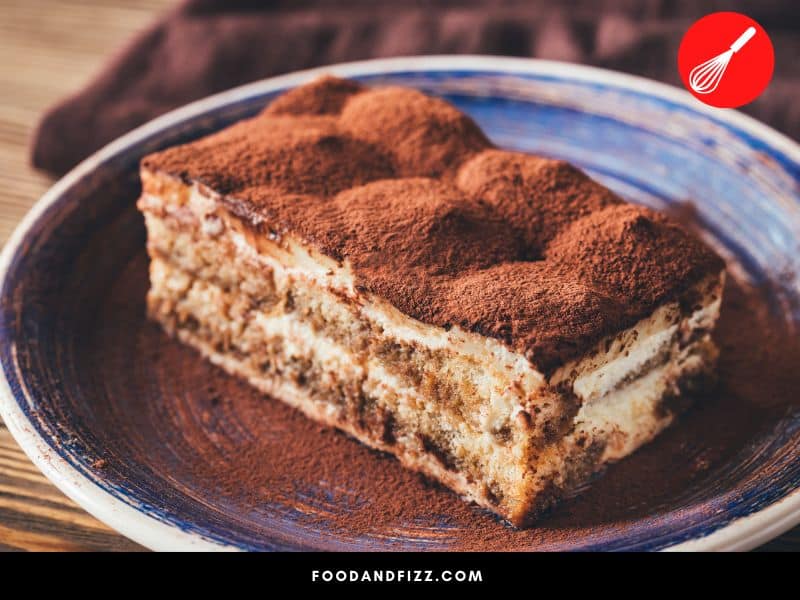
5. Panna Cotta
Panna cotta is an Italian custard made with cream or milk, sugar, vanilla, and gelatin, although other flavorings may be added depending on the region. Its name means “cooked cream” in Italian.
It is a simple, satisfying, creamy meal-ender that is considered a classic dessert in the Piedmont region. It can be served with a variety of sauces and toppings but when done right, is sufficiently satisfying on its own.
- Characteristics: Sweet, creamy, and delicate, with a smooth texture
- Featured Ingredient: Cream
- Type of Dish: Dessert
- Region of Origin: Piedmont

6. Focaccia
Focaccia is a leavened, yeasted flatbread that looks quite similar to pizza, except that it is a bit thicker. Its shape can be rectangular or square, but it can also be round.
It is usually savory but can be sweet as well. It is commonly flavored with herbs, spices, olive oil, and vegetables, but like pizza, the ingredients would depend on what region you are in.
The Liguria region of Italy, specifically Genoa, is thought to be the birthplace of traditional Italian focaccia. Foccacia Genovese or Fugassa is a soft, spongy bread about ½ inch thick that is generously brushed with olive oil and sprinkled with sea salt, to get that distinctive crispy crust.
It is likely the bread you think of when you think of Foccacia. It is simple, delicious, and is a nice accompaniment to various dishes.
I actually make my focaccia this way, but sometimes I add rosemary for added aroma and flavor. The whole house smells amazing for hours after I make this!
- Characteristics: Yeasted flatbread that is similar to but thicker than pizza, usually savory but can be sweet, made with olive oil, herbs, spices, and vegetables
- Featured Ingredient: Olive oil, both for texture and flavor
- Type of Dish: Can be served as a side dish or used in sandwiches
- Region of Origin: Genoa, Liguria

7. Rise e Bisi (Rice and Peas)
Risi e Bisi is a Venetian rice dish that was traditionally prepared as a springtime offering to the Doge of Venice, to celebrate the feast of San Marco on April 25.
Spring is when fresh, young peas are in season, and where they are at their smallest, sweetest and softest, which lends an incomparable flavor to the simple dish.
The texture of Risi e Bisi is somewhere between a risotto and a hearty, creamy soup, and though the ingredients are few and simple, is pretty satisfying when done right.
In the absence of fresh, young peas, some expert cooks say that frozen or tinned varieties may work in some cases, although of course, the flavor would not be the same as when using fresh.
- Characteristics: Creamy, hearty soup made with fresh young peas and Italian rice
- Featured Ingredient: Fresh, young green peas
- Type of Dish: Main dish, entree
- Region of Origin: Veneto

8. Fonduta
Did you know that Italy also has its own version of cheese fondue? Known as fonduta, this version of the beloved cheese dish hails from the alpine area of Valle d’Aosta in Northwestern Italy, an area bordered by France and Switzerland.
Unlike the Swiss version, the Italian fonduta does not have white wine or garlic in it and is instead comprised of the famous Fontina cheese, milk, egg yolks, and flour.
White truffles, a specialty of Piedmont in the same area, are sometimes added to the dish or served on the side.
Like its Swiss cousin, fonduta is served with bread and is a dish that is meant to be shared with others.
- Characteristics: Rich, creamy melted cheese dish for dipping bread, communal dish
- Featured Ingredient: Fontina cheese
- Type of Dish: Appetizer, Main Dish, meant to be shared
- Region of Origin: Aosta Valley, Piedmont
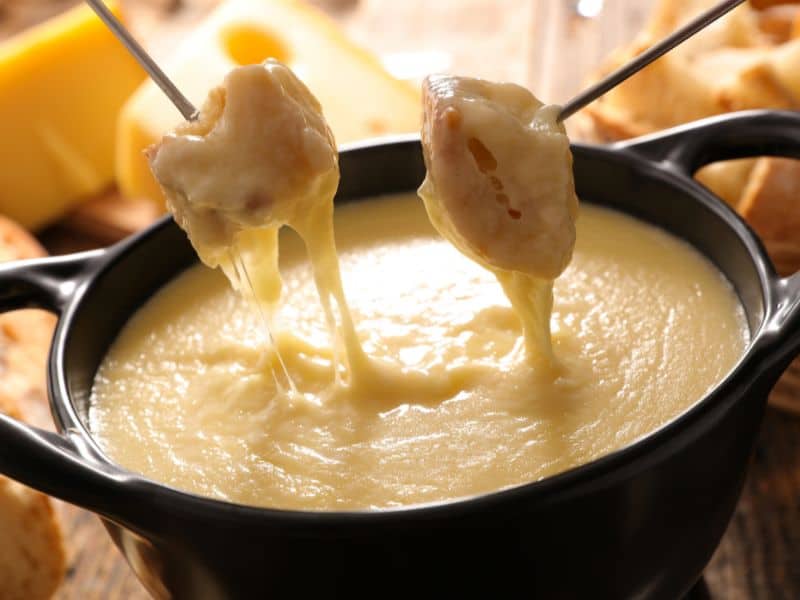
9. Fegato Alla Veneziana
This liver dish is one of the most famous in Venetian culinary tradition.
It has its roots in a similar dish in ancient Rome, but instead of using the sweetness of figs to mellow the strong and bitter taste of the liver, the Venetian version used the sweetness of caramelized onions, which are more readily available in the area.
Sometimes vinegar, white wine, or lemon juice is also added to the mix to further balance the flavors out. Fegato Alla Veneziana is typically served with polenta, bread, or potatoes.
- Characteristics: Liver with onions, has its roots in a dish in ancient Rome, strongly flavored
- Featured Ingredient: Typically calf’s liver, onions
- Type of Dish: Main dish served with polenta, potatoes, or bread
- Region of Origin: Venice, Veneto
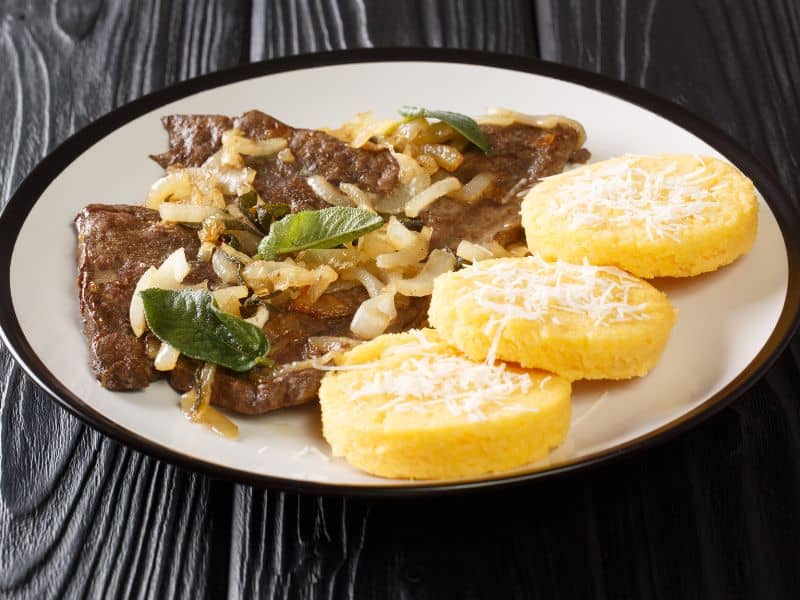
10. Ragu Alla Bolognese
The spaghetti Bolognese sauce we are used to is actually not the same as the Ragu Alla Bolognese common in the Emilia-Romagna region of Italy.
The common usage of Bolognese sauce as we know it pertains to a tomato-based sauce with minced meat added.
Ragu Alla Bolognese, however, is actually a more complex dish that involves several types of minced or chopped beef and pork, slow-cooked and simmered for a long period of time to produce a thick sauce. Ingredients like white wine, milk, and tomatoes help give the sauce depth and flavor.
In Bologna, it is typically served with tagliatelle, but other flat and broad types of pasta may be used, as well as pasta with sturdier shapes like rigatoni.
Hearty meat sauces do well with sturdier types of pasta, as they can more effectively scoop up those tender pieces of meat, unlike, for example, more delicate kinds of pasta like angel hair.
- Characteristics: Rich, hearty, slow-cooked meat sauce
- Featured Ingredient: Beef and Pork
- Type of Dish: Served with flat pasta like tagliatelle, or other sturdy pasta shapes
- Region of Origin: Bologna, Emilia-Romagna
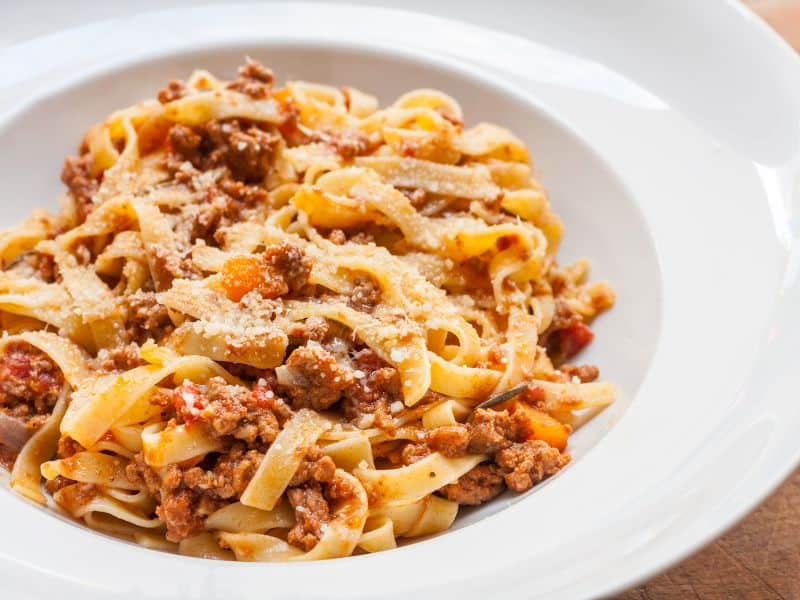
11. Canederli
Canederli is the Italian version of the Eastern and Central European knödel, or boiled bread dumplings. It is made from old bread, eggs, milk, and flour.
In the Trentino region of Italy where it is a staple, it is commonly mixed with local cured meat like speck, cheese, and other flavorings.
It is then boiled and served either in broth or soup or served as a side to other sauce-heavy dishes. It is a very common dish in the Trentino-Alto Adige area of Italy, which is flanked by Switzerland and Austria on its borders.
- Characteristics: Boiled dumplings made with stale bread, cured meat, cheese, and flavorings
- Featured Ingredient: Old bread
- Type of Dish: Appetizer or Main Course, served in broth or dry
- Region of Origin: Trentino-Alto Adige
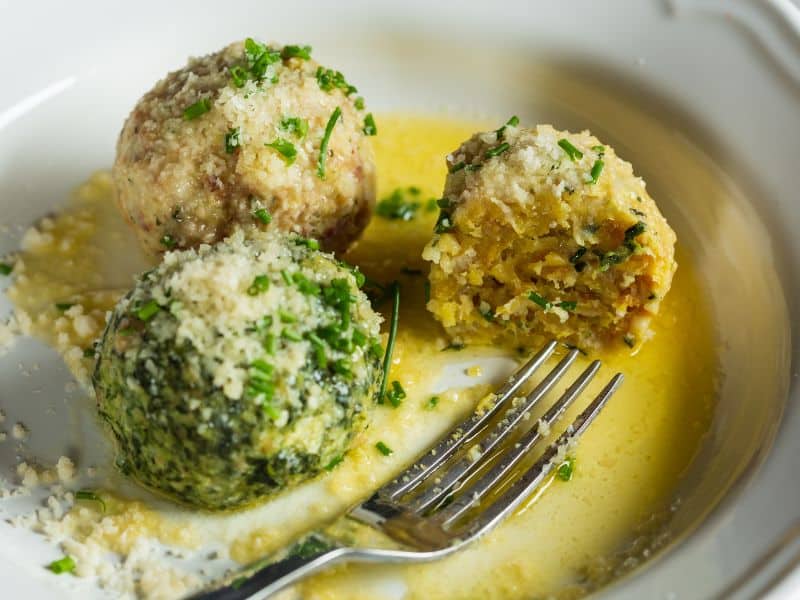
12. Gnocchi
Gnocchi is another popular food that originated in Northern Italy, although like pizza and pasta, different versions exist across different regions.
Gnocchi is basically made up of a mixture of potatoes, eggs, and flour, which are then shaped into little lumps of dough, boiled, and then dressed up in various dressings and sauces.
The most common way to serve them is by tossing them in a light butter sauce with fresh sage, but it is very versatile and can work with things like pesto or ragu.
It can be as light or as hearty as you want it, depending on the choice of sauce and vegetables and cheese you choose to mix in with it.
- Characteristics: Boiled potato dumplings, served similar to pasta
- Featured Ingredient: Potatoes
- Type of Dish: First course, appetizer, or main dish
- Region of Origin: Piedmont, North Italy
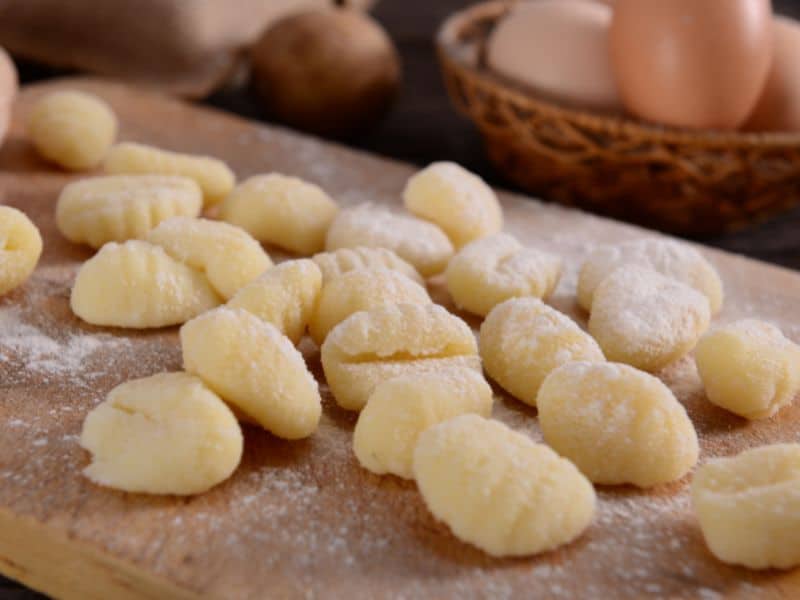
13. Baccala Mantecato
A popular Venetian appetizer made with salt cod, olive oil, lemon, garlic, parsley, salt, and pepper. The fish is poached in water or milk and then whipped to a fluffy consistency similar to a mousse.
It is served with toasted or grilled polenta or bread. This dish is common in bars but is also common in family get-togethers.
- Characteristics: Poached salt cod whipped with garlic, salt, and pepper, served with polenta
- Featured Ingredient: Baccala or salt cod
- Type of Dish: Appetizer
- Region of Origin: Venice, Veneto

14. Capriolo Alla Valdostana
This is a rich and hearty venison stew popular in the Aosta Valley region of North Italy. It requires a very long preparation process that’s why it is usually reserved for special and festive occasions.
Venison is marinated for a minimum of 12 hours in vinegar and pepper, and then slow-simmered in vegetables, garlic, spices like cloves and cinnamon, and interestingly enough, Grappa.
Grappa is a popular after-dinner drink in Italy, and is a specialty of this region. As with most Northern Italian dishes it is typically served with polenta or egg pasta.
- Characteristics: Rich, hearty venison stew infused with Grappa
- Featured Ingredient: Venison, Grappa
- Type of Dish: Stew, served with polenta or pasta
- Region of Origin: Aosta Valley
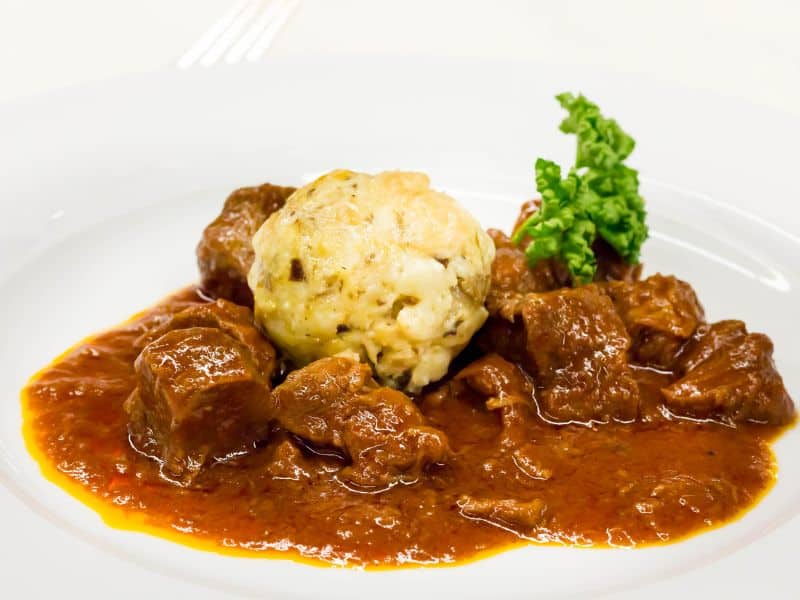
15. Brasato Al Barolo
Another slow-cooked meat dish showcasing two of Piedmont’s most prized products: beef and Barolo wine.
Piedmontese beef is prized because of its leanness and natural tenderness, and Barolo wine, made from Nebbiolo grapes, is considered among the best wines in all of Italy.
These two things come together in a rich, elegant dish that showcases the unique personality of the region.
- Characteristics: Beef slow-cooked in Barolo wine, rich, hearty and elegant, good for special occasions
- Featured Ingredient: Piedmontese beef, Barolo wine
- Type of Dish: Stew, served over polenta
- Region of Origin: Piedmont
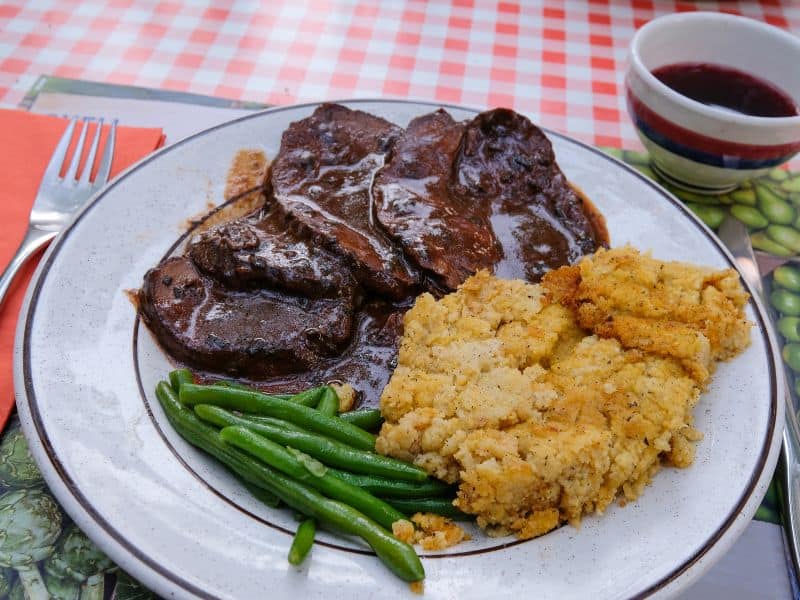
16. Ravioli
Ravioli, or stuffed pasta is a huge part of Northern Italian tradition, with many shapes and variations depending on the area. It made its first appearance in Italian cuisine in the 1500s and was originally only for aristocrats and nobles.
Over time, it became more accessible to common people, who modified the fillings based on what they had available, which likely explains why ravioli has so many different versions and variations.
Ravioli is thin pasta dough that contains a filling of meat, seafood, cheese, or vegetables, and can be served either in a broth or a sauce.
It is typically square-shaped, although round shapes exist as well. Ravioli di Zucca, a famous type of ravioli from the Lombardy region, is made up of pumpkin, amaretti cookies, nutmeg, and cheese, tossed in a sage butter sauce.
- Characteristics: Thin pasta dough with meat or vegetable filling, tossed in sauce or broth
- Featured Ingredient: Depending on the region, the filling can be light or hearty
- Type of Dish: Main dish, pasta
- Region of Origin: Lombardy
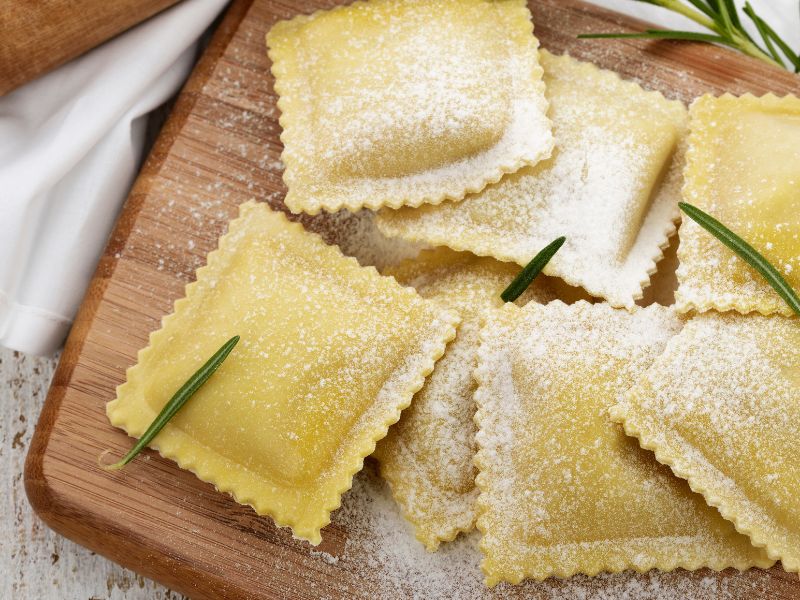
17. Polenta
Polenta is a staple food in North Italy, served alongside various meat and seafood dishes. It is made with coarsely ground cornmeal, and when just boiled, it has a creamy, porridge-like consistency.
As it cools down, it becomes firm and can be sliced and fried, grilled, or baked before serving with dishes.
It can be used as a substitute to potatoes or pasta. Polenta is said to have originated as a staple food for Italian farmers.
- Characteristics: Boiled coarsely ground corn, porridge-like when just boiled, firms up as it cools
- Featured Ingredient: Corn
- Type of Dish: Accompaniment to main dishes, an ingredient in desserts
- Region of Origin: North Italy
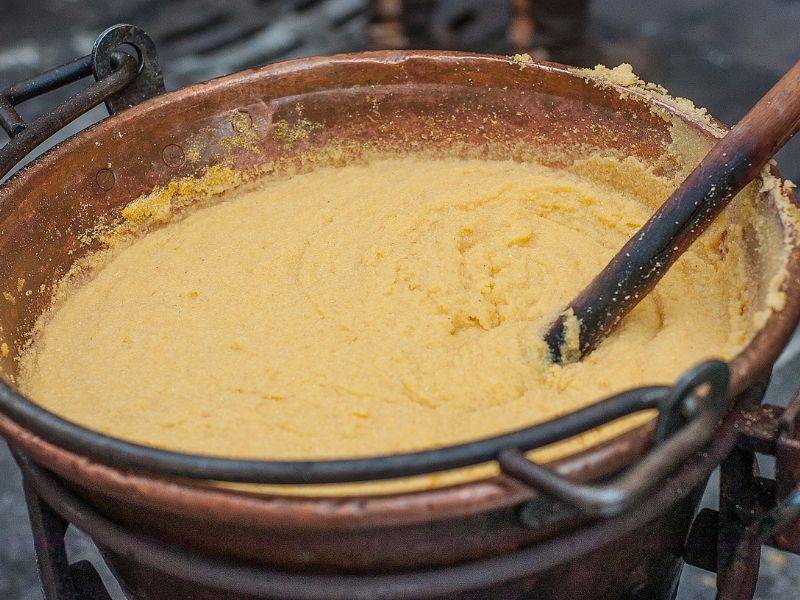
18. White Truffles
The city of Alba in Piedmont in northern Italy is known as the “White Truffle Capital of The World”.
Every year, from September to December, foodies, and enthusiasts flock to this picturesque city to catch a whiff of this highly prized tuber that grows abundantly in the forests in this region.
Truffles grow underground near hardwood trees like oaks and hazelnuts and belong to the tuber family. They are pale gold in color, and lumpy in shape, looking almost like potatoes.
While they also grow in other regions, the white truffle from Alba, known as tuber magnatum, is the most desired.
It is also the most expensive, because of its unique flavor, which is due to the unique climate and composition of the soil in the region.
White truffles have an earthy, musky aroma and taste, with notes of garlic or shallots. They are shaved finely and sprinkled raw on pasta, risottos, and other dishes, which immediately elevates the flavor and aroma of the dish.
As an interesting side note, Alba is also the town where Nutella and Ferrero chocolates come from.
- Characteristics: Pale gold tubers with a distinct taste and aroma
- Featured Ingredient: White Truffles
- Type of Dish: Sprinkled raw over pasta, risotto, and other dishes
- Region of Origin: Alba, Piedmont
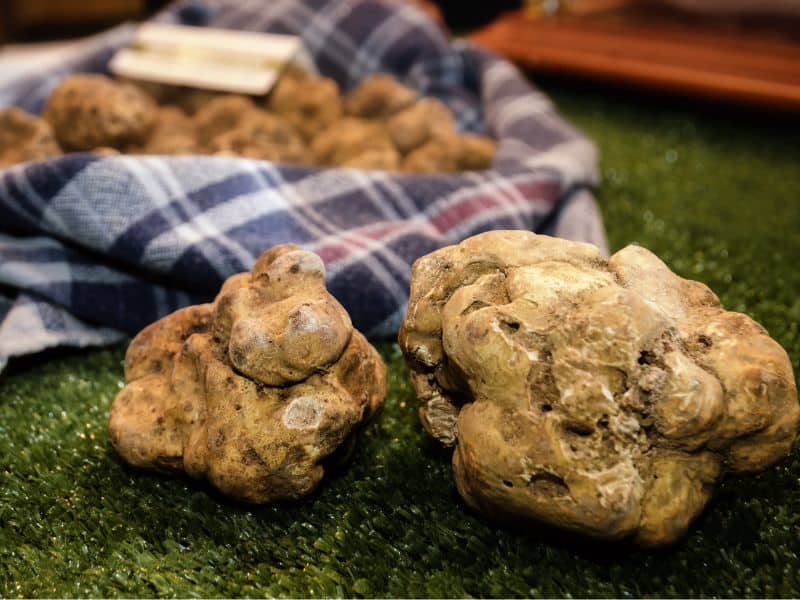
19. Balsamic Vinegar
The province of Modena in the Emilia-Romagna region in Northern Italy is known for its Balsamic vinegar.
Balsamic vinegar is a dark-colored vinegar made from freshly crushed grape juice, including the seeds, stems, and seeds, and aged for years in wooden barrels.
It is sweeter and lower in acidity compared to other kinds of vinegar, with flavors of chocolate or molasses, and depending on how long and what type of barrel it was aged in, can take on a smoky flavor, too.
- Characteristics: Dark, sweet, less acidic vinegar made with grape must
- Featured Ingredient: Grapes
- Type of Dish: Condiment or Ingredient
- Region of Origin: Modena, Emilia-Romagna
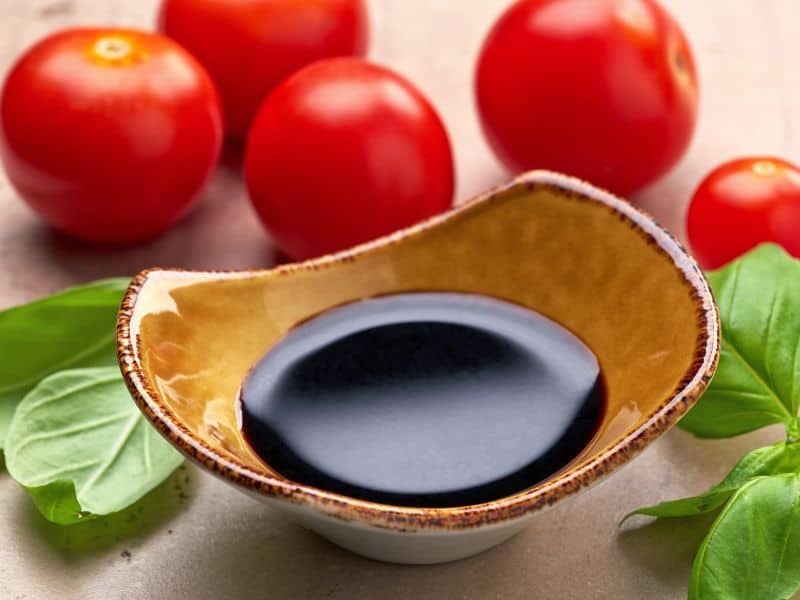
20. Prosciutto Di San Daniele and Prosciutto di Parma
Cured meat or “salumi” in Italian, is a big part of Italian cuisine no matter where you go. There are some, though, that are more prized than others, and enjoy protected status.
Protected Designation of Origin and other similar titles ensure that only products that are produced in the specific area, following the strict manufacturing and approval processes, are the only ones allowed to be called by that particular product name or brand name.
This protects the integrity of the product, especially of a high-quality, heritage food. This means that not anyone can just claim to sell that product and make money off of the established product name.
Prosciutto Di San Daniele PDO and Prosciutto di Parma PDO are just two products that enjoy that special status. Prosciutto, in Italian, can refer to any type of processed ham, cured and uncooked or cooked, processed in any region.
Prosciutto di San Daniele can only refer to prosciutto that’s sourced from pigs raised in specified regions of North and Central Italy, raised in a traditional way, and aged in San Daniele, a small village in the Northern Italian region of Friuli Venezia Giulia.
It can only be called Prosciutto di San Daniele if it meets all of the requirements.
Similarly, Prosciutto di Parma or Parma Ham can only be called as such if sourced from approved areas in North Central Italy and produced in the Parma region of Emilia-Romagna, using the age-old traditions that are closely monitored by the Parma Ham Consortium.
This makes sense both from a commercial and practical point of view, as it allows manufacturers to control the quality of the product and protect the name.
Practically speaking, it is also quite difficult to replicate it elsewhere anyway. The specific mix of climate and environment, the lifestyle and diet of the pigs, and the way they are raised play a huge role in the final flavor of the product, all of which are unique to the region.
To learn more about prosciutto and Parma Ham, check out the article Parma Ham vs. Prosciutto – The #1 Important Difference on the site.
- Characteristics: Dry-cured, unsmoked and uncooked ham aged for several years. Prosciutto di San Daniele is firmer, saltier, and has a stronger flavor. Parma Ham is sweeter and milder in flavor.
- Featured Ingredient: Special heritage pork legs
- Type of Dish: Antipasto, served thinly sliced
- Region of Origin: Friuli Venezia Giulia, Emilia-Romagna
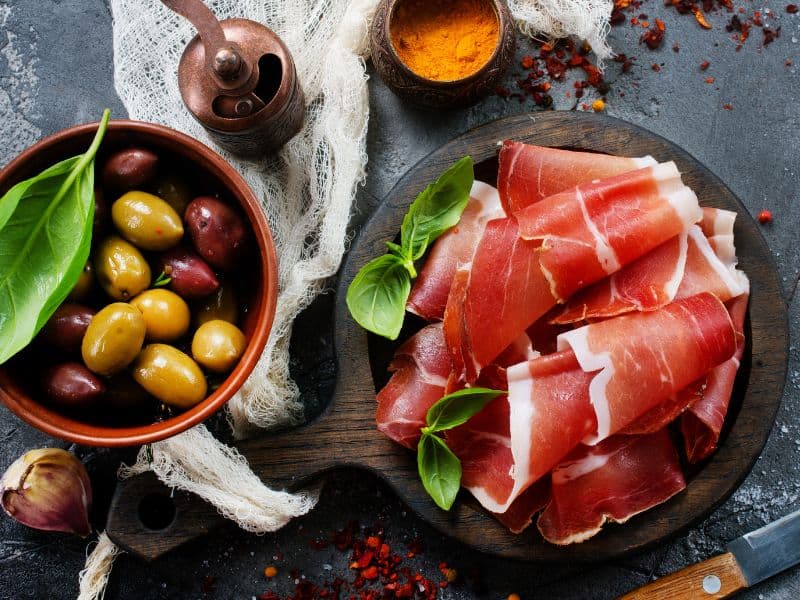
21. Speck
Continuing our cured meat journey, we come to speck, related to prosciutto but also markedly different. Speck is a type of cured meat that is also lightly smoked, unlike prosciutto.
Authentic speck also has protected status, known as Speck Alto Adige IGP or Indication of Geographic Protection, which means that if your speck is authentic, there should be at least one stage of the production process that is done within a specified geographical location.
Speck is darker brown in color and also has a denser texture. It is cured with juniper and bay leaf, so it has more of a smoky and savory taste than its cousins.
It is also more aromatic than prosciutto. It is a specialty of the South Tyrol or Alto Adige region in the northernmost part of Italy, bordering Austria.
- Characteristics: Cured pork legs, lightly smoked, denser, savory, smoky, aromatic
- Featured Ingredient: Pork legs cured in juniper, bay leaves
- Type of Dish: Antipasto, a snack, can be mixed in canederli, or bread dumplings
- Region of Origin: South Tyrol, Alto Adige

22. Bresaola
At first glance, bresaola can look like any other typical cured Italian meat. However, what sets it apart from the others is that it isn’t actually a cured pork product, but rather, it is made with beef, and lean beef at that.
Bresaola is a specialty of the Lombardy region of Italy and is made from a single cut of beef, specifically the eye of the round cut, which is a leaner cut. It is cured with a mix of salt, white pepper, nutmeg, and other spices depending on the artisan making it.
It is typically cured for at least 85 days. It has a darker color than prosciutto, almost purple, but can be served and used in the same way.
- Characteristics: Aromatic, salty, milder in flavor, and less fatty than prosciutto. Dark red to purple in color.
- Featured Ingredient: Cured and air-dried lean beef
- Type of Dish: Antipasto
- Region of Origin: Valtellina, Lombardy
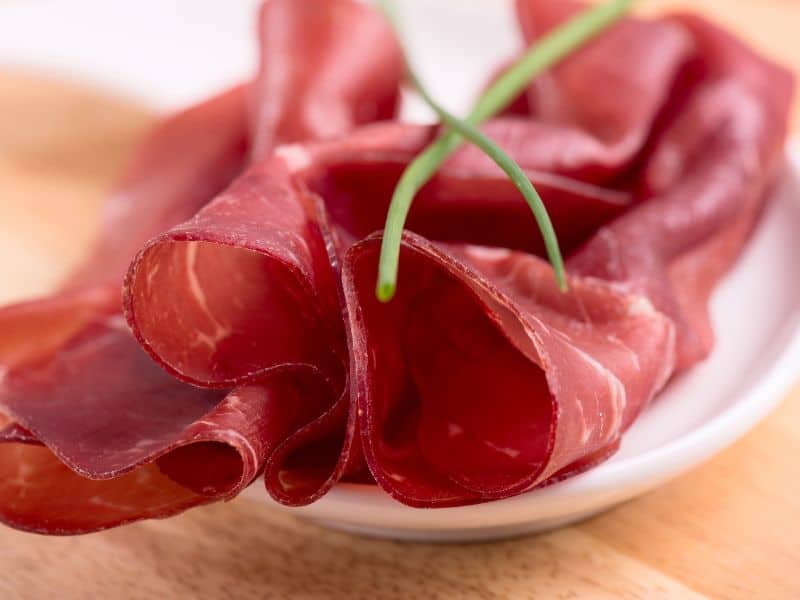
23. Parmigiano Reggiano
Parmigiano Reggiano, or Parmesan cheese, is a type of hard, granular cow’s milk cheese that is processed and aged for several years.
It has a rich, nutty flavor, and the more it is aged, the flakier and crumblier and the more soluble it gets. It is one of the most popular cheeses and has been called the “King of Cheese.”
Cheese that’s specifically called Parmigiano Reggiano is a product with protected status, which means that authentic Parmigiano Reggiano can only come from the areas of Parma, Reggio Emilia, parts of Bologna, Modena, and Mantua in Lombardy.
There is a very specific region where it can be processed and produced, and it is also closely monitored for quality.
This means that all other cheeses called Parmesan or Parmigiano outside of these areas are different. Not to say that they are not good, but just that they cannot authentically be called Parmigiano Reggiano, and may differ in quality and taste.
In the U.S., Parmesan cheese isn’t really regulated, so that packet of grated parmesan cheese in the grocery store isn’t really the same as the one you would get in Italy.
Some artisan producers may produce cheese in a similar style, but for a true experience of the real thing, it’s a good idea to get one that is produced specifically in the designated Parmigiano Reggiano areas.
- Characteristics: Hard, granular cheese, rich, nutty flavor, King of Cheese
- Featured Ingredient: Made from cow’s milk and aged for at least two years
- Type of Dish: Cheese
- Region of Origin: Parma, Reggio Emilia, Emilia-Romagna region

24. Fontina
Fontina is a semihard cheese traditionally made from the milk of unpasteurized cows in the Aosta Valley in northern Italy. The area has been making fontina cheese in this way since the 12th century.
Fontina cheese from this area is sharper and more pungent than fontina produced from other areas, and it also has protected status, meaning, the specific kind of Fontina cheese must be made in this area and made in a specific way (milk must be used whole, within two hours of milking), with milk from a specific breed of cows (Valdostana breed).
Fontina cheese made in other areas is usually called by a different name, fontal.
Fontina cheese is pale yellow in color and has a smooth texture with little holes called eyes. It is rich, pungent, and strong tasting, and also creamy with a nutty and buttery flavor.
The Italian version of cheese fondue, fonduta, uses fontina cheese as the main ingredient.
- Characteristics: Sharp, pungent, rich, creamy, nutty semisoft to hard cheese
- Featured Ingredient: Unpasteurized cow’s milk from the Aosta Valley
- Type of Dish: Cheese
- Region of Origin: Val D’Aosta, Aosta Valley
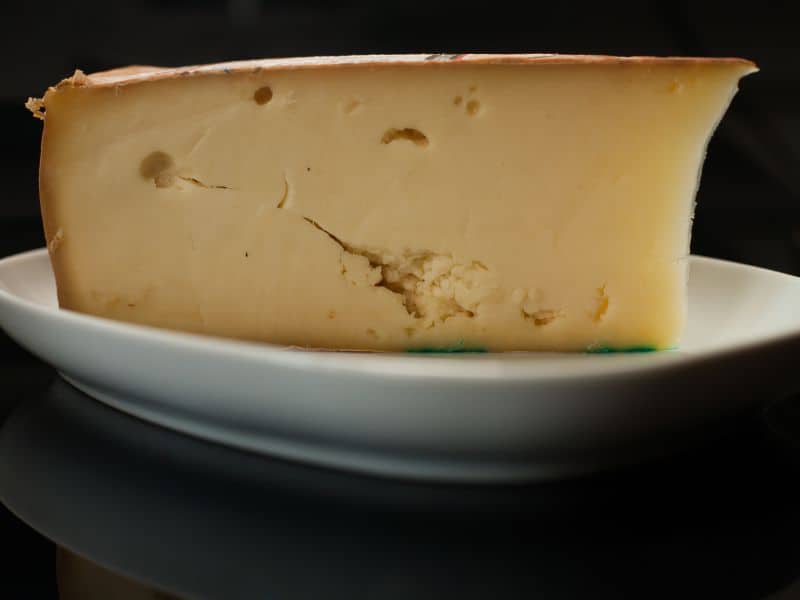
25. Mascarpone
Mascarpone is a fresh, creamy, and smooth, acid-set Italian cream cheese. Its most popular use is in the coffee-flavored dessert, Tiramisu. It is white in color, creamy, and very easy to spread.
It is sweeter and less acidic than cream cheese or crème Fraiche and has a buttery flavor due to its high butterfat content.
It originated in the region of Lombardy, in an area south of Milan between Lodi and Abbiategraso, likely in the 16th or 17th century.
Mascarpone has a PAT (Prodotti Alimentari Tradizionali) designation within Italy, or a food considered a traditional, regional agriproduct.
- Characteristics: White, fresh, creamy and smooth, sweet and tangy acid-set cream cheese
- Featured Ingredient: Cream
- Type of Dish: Cheese
- Region of Origin: Lombardy
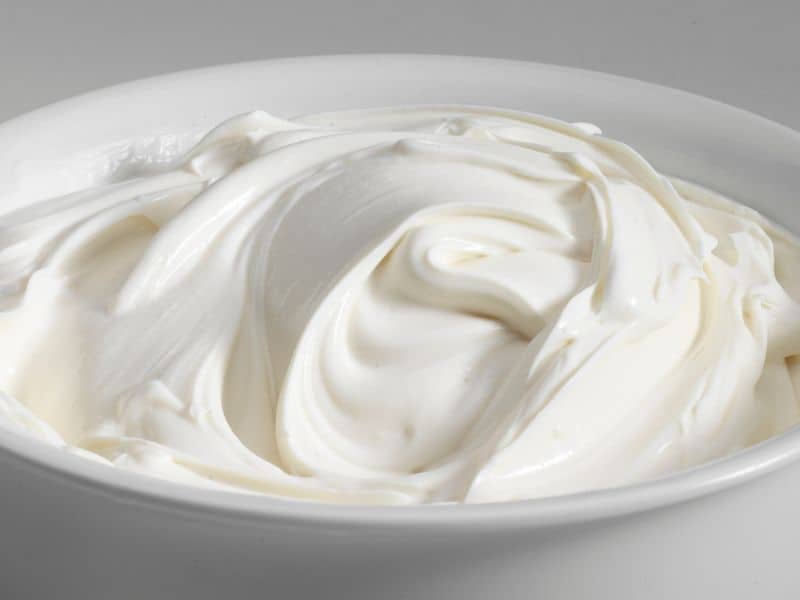
26. Gorgonzola
Gorgonzola is a veined, cow’s milk blue cheese that is produced predominantly in the area of Piedmont and Lombardy and is a cheese named after the town of Gorgonzola, a town in Milan, where it is said to have originated from.
Gorgonzola is pale yellow to white in color with a pretty blue-green marbling. Young gorgonzola is soft, creamy, and can be buttery, while more mature gorgonzola can be sharper and stronger, and more pungent.
Gorgonzola can be added to pizzas and pastas for an interesting flavor and texture, and because of its pretty color and texture, also makes a nice addition to your cheeseboard.
- Characteristics: Salty, earthy, full-flavored
- Featured Ingredient: Made from cow’s milk
- Type of Dish: Cheese
- Region of Origin: Lombardy, Piedmont
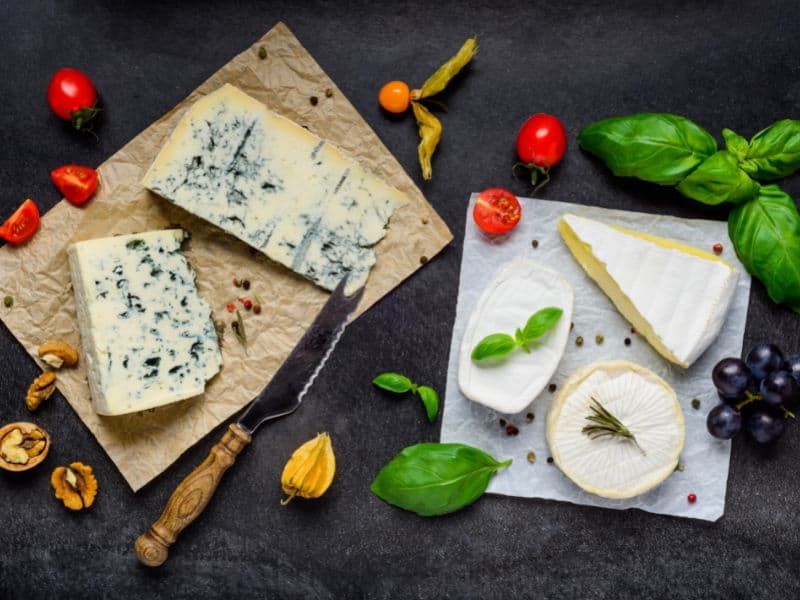
Conclusion to 26 Most Popular Northern Italian Foods
Italian food is more than just pizza and pasta. In North Italy especially, rich and hearty meat, seafood, and rice dishes are common, as well as the use of more cream and butter.
Certain iconic Italian products can be traced back to the North of the country, such as Prosciutto di Parma, Balsamic Vinegar of Modena, White Truffles of Alba, and even Tiramisu.
These iconic foods have not only made North Italy a favorite gastronomic destination but have also catapulted the fame of Italian cuisine in general on the world stage.

